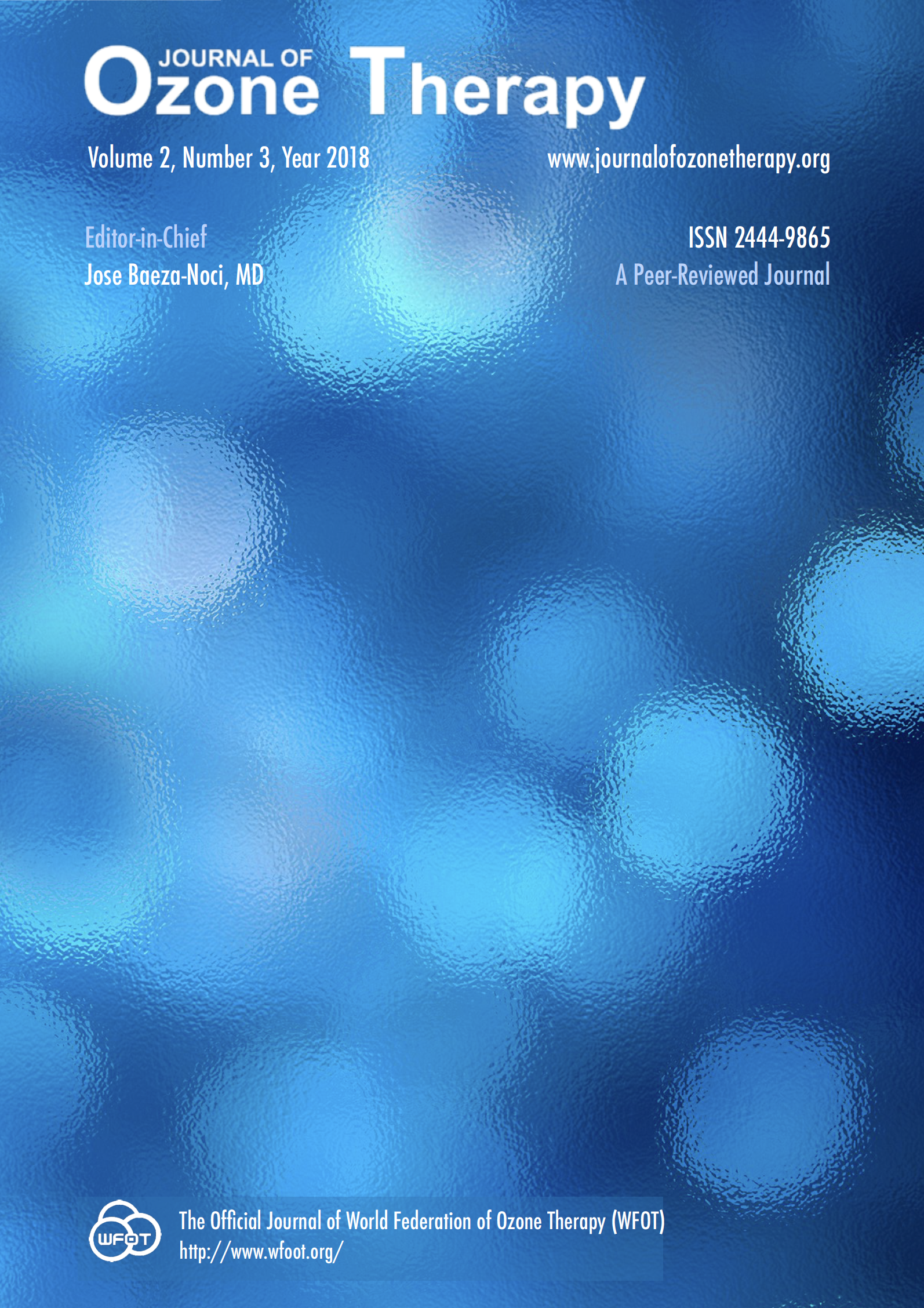The immune response behavior in HIV-AIDS patients treated with ozone therapy for two years
DOI:
https://doi.org/10.7203/jo3t.2.3.2018.11458Keywords:
Ozone therapy, HIV-AIDS, Immune Response, Major Autohemotherapy Abstract
Abstract
HIV continues to be one of the biggest problems for the global public health. The African region is one of the most affected, accounting for almost two thirds of the new infections. Many of them are retroviral medications and multi-therapies aiming to stop the viral replication and maintaining immunological stability, which fail to guarantee the quality of life or enhance the patient's immunity
Ozone has biological properties, among which the antimicrobial and modulatory effect on the immune response is highlighted, which makes it possible to use it in a complementary way for the treatment of these patients.
We conducted the present study in which the effect of the ozone therapy administered systemically (blood route) is analyzed. We have studied 32 patients to whom we applied Major Autohemotherapy with a protocol of 15 sessions and maintenance every 15 days at 50 µg/ml of concentration; the initial dose was 4,000 µg/mlup to 12,000 µg/ml
We indicated viral load, CD4 and CD8 counts before and at the end of therapy. The results showed a significant decrease in viral load to undetectable values and an increase of CD4 and CD8 at the end of the 15 sessions, being maintained at 2 years of treatment, thus achieving a permanent activation of the immune system and improving the quality of life of these patients.
Key words: Ozone therapy, HIV-AIDS, Immune Response, Major Autohemotherapy
 Downloads
Downloads
 References
References
WHO. HIV/AIDS [internet]. Geneve: WHO; 2018 [cited 2017 Jul 20]. Available from: https://www.who.int/es/news-room/fact-sheets/detail/hiv-aids
Index Mundi. Angola HIV/AIDS adult prevalence rate [internet]. Charlotte (NC): Index Mundi; 2016 [cited 2017 Feb 02]. Available from: https://www.indexmundi.com/angola/hiv_aids_adult_prevalence_rate.html
Vicente-Peña E. Medicina Interna. Diagnóstico y Tratamiento [Internal Medicine. Diagnosis and Treatment]. 2nd ed. La Havana: Editorial Ciencias Médicas; 2016.
Hammer SM, Squires KE, Hughes MD, Grimes JM, Demeter LM, Currier JS, et al. A controlled trial of two nucleoside analogues plus indinavir in persons with human immunodeficiency virus infection and CD4 cell counts of 200 per cubic millimeter or less. AIDS Clinical Trials Group 320 Study Team. N Engl J Med. 1997 Sep;337(11):725-733. doi: 10.1056/NEJM199709113371101.
Demeter LM, Hughes MD, Coombs RW, Jackson JB, Grimes JM, Bosch RJ, et al. Predictors of virologic and clinical outcomes in HIV-1-infected patients receiving concurrent treatment with indinavir, zidovudine, and lamivudine. AIDS Clinical Trials Group Protocol 320. Ann Intern Med. 2001 Dec;135(11):954-964.
Volberding PA, Deeks SG. Antiretroviral therapy for HIV infection: promises and problems. JAMA. 1998;279(17):1343-1344.
Bocci V. Oxygen-Ozone Therapy. A Critical Evaluation. Dordrecht (NL): Kluwer Academic Publishers; 2002. 440 p. ISBN: 9789401599528.
Bocci V. Ozone. A new medical drug. Dordrecht (NL): Springer; 2005. 324 p. ISBN: 9789048192342.
Travagli V, Zanardi I, Silvietti A, Bocci V. A physicochemical investigation on the effects of ozone on blood. Int J Biol Macro Mol. 2007;41(5):504-511. doi: 10.1016/j.ijbiomac.2007.06.010.
Larini A, Bocci V. Effects of ozone on isolated peripheral blood mononuclear cells. Toxicol in Vitro. 2005 Feb;19(1):55-61. doi: 10.1016/j.tiv.2004.06.007.
Abbas AK. Activation of lymphocytes. In: Abba AK, Lichtman A. Cellular and Molecular Immunology. 7th ed. New York (NY): WB Saunders Co. 2011. p. 203-224. ISBN: 9780323278423.
Hooker MH, Gazzard BG. Ozone-treated blood in the treatment of HIV infection. AIDS. 1992 Jan;6(1):131.
Huanqui P, Cruz M, Miranda A, Patrica P, Mamani R. Eficacia y seguridad del ozono intraarticular en ambas rodillas refractaria al tratamiento [Efficacy and safety of intraarticular ozone in both knees refractory to treatment.]. Rev Peru Reum. 2006;12(1):21-26. Available from: http://www.sld.cu/galerias/pdf/sitios/rehabilitacion-doc/gonartrosis_ozono.pdf
Rhee SG, Bae YS, Lee SR, Kwon J. Hydrogen peroxide: a key messengers that module protein phosphorylation through cysteine oxidation. Sci STKE. 2000;2000(53):1. doi: 10.1126/stke.2000.53.pe1.
Mendez I, Menendez S, Rivero J. Ozonoterapia en SIDA. Reporte de un caso [Ozone therapy in AIDS. A case report]. Rev Cubana Invest. Biomed. 2005;24(1):69-71. Availble from: http://scielo.sld.cu/pdf/ibi/v24n1/ibi09105.pdf
Li Q, Verma IM. Nf-kB regulation in the immune system. Nat Rev Immunol. 2002 Oct; 2(10):725-734. doi: 10.1038/nri910.
Reth M. Hydrogen peroxide as second messenger in lymphocyte activation. Nat. Immunol. 2002;3(12):1129-1134. doi: 10.1038/ni1202-1129.
Gonzalez-Ramirez J. Caso clínico Paciente pediátrico con VIH [Case report. A HIV pediatric patient]. Ciudad de Mexico: Asociacion Mexicana para el diagnostico y tratamiento de enfermedades autoinmunes, AC; 2016 [cited 2017 Jul 20]. Available from: http://www.autohemoterapia.org.mx/casos-clinicos/pac-pediatrico-con-vih.pdf
Abbas AK. Cytokines- appendix II. In: Abba AK, Lichtman A. Cellular and Molecular Immunology. 7th ed. New York (NY): WB Saunders Co; 2011. p. 501-504. ISBN: 9780323278423.
Bocci V, Luzzi E, Corradeshi F, Paulesu L, Di-Stefano A. Studies on the biological effects of ozone: 3. An attempt to define conditions for optimal induction of cytokines. Lymphokine Cytokine Res. 1993 Apr;12(2):121-126.
Garber GE, Cameron DW. The use of ozone-treated blood in the therapy of HIV-infection and immune disease: a pilot-study of safety and efficacy. AIDS. 1991;5(8):981-984.
Díaz-Luis J, Menéndez-Cepero S, Macías-Abraham C, Fariñas-Rodríguez L. Systemic ozone therapy by rectal insufflation for Immunoglobulin A deficiency. MEDICC Review. 2018 Jan;20(1):29-35. Available from: http://mediccreview.org/wp-content/uploads/2018/04/mr_616.pdf
Downloads
Published
How to Cite
-
Abstract7195
-
PDF2508
Issue
Section
License
Journal of Ozone Therapy applies the Creative Commons Attribution-NonCommercial 4.0 International License (CC BY NC 4.0) license to works we publish.
Under this license, authors retain ownership of the copyright for their content, but allow anyone to download, reuse, reprint, modify, distribute and/or copy the content as long as the original authors and source are cited. No permission is required from the authors or the publishers.
You may not use the material for commercial purposes.
Appropriate attribution can be provided by simply citing the original article, provide a link to the license, and indicate if changes were made.
You may do so in any reasonable manner, but not in any way that suggests the licensor endorses you or your use.




